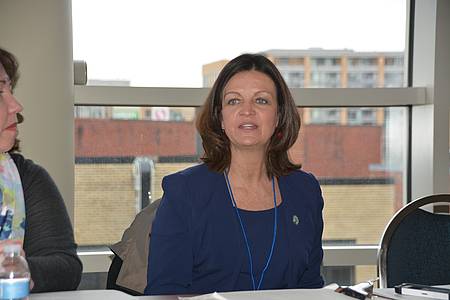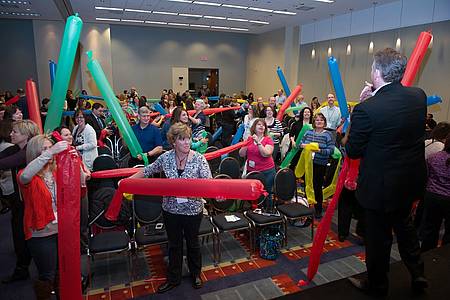Teaching and Learning Conference: Knowledge Meets Inspiration
Several thousand teachers attended two days of the inaugural National Board for Professional Teaching Standards event
Several thousand teachers attended two days of the inaugural National Board for Professional Teaching Standards event

“I need to stay inspired and encouraged and find out what's going on, then take it back and share with my district.”

As described by a teacher trainer from Florida, leadership and collaboration were the unofficial theme of the Teaching and Learning 2014 conference in Washington, DC in March. Several thousand teachers from across the country attended two days of workshops and plenaries as part of the inaugural event, which was held by the National Board for Professional Teaching Standards, a Carnegie Corporation grantee.
The conference attracted administrators, policymakers and even a bit of star power with musician Bobby McFerrin, journalist George Stephanopoulos, and author Doris Kearns Goodwin. Secretary of Education Arne Duncan chose this opportunity to announce a new initiative with the National Board called “Teach to Lead.” He plans to convene teachers, principals, district and state leaders, and others who share this goal.
“Our aim is to encourage schools and districts, and hopefully, even states, all over the country to provide more opportunities for genuine, authentic teacher leadership that don't require giving up a daily role in the classroom.”
Above all, the conference was a professional development immersion for teachers. Workshops ranged from classroom activities aligned with the Next Generation Science Standards to new school models that use community partnerships to provide social services in high-needs schools. The focus on STEM was a big draw for Natalie Morales, a high school science teacher and district leader in New York. At a session on how best to develop a STEM Master Teachers Corps, she offered ideas on strengthening the profession:
“I think a national program would be important to have. We need to connect with universities and industries so that teachers can bring all that back to the classroom where the kids can benefit and be engaged.”

Most of the teachers attending the conference earned a voluntary national certification in their subject areas through the National Board. The nonprofit organization was formed in 1987 as the result of the Carnegie Corporation Task Force on Teaching as a Profession that sought to revitalize the teaching profession. Stephanie Gullage of Louisiana is certified in early adolescent mathematics and says it is worth the extra work.
“Being a nationally certified teacher means that I had to really hone my craft. It means I can teach the higher maths, but I can also teach the higher concepts at lower levels to make it reachable for students at all levels of learning.”
This integration of high levels of content is critically important if students are going to meet the requirements of the Common Core, according to Michele Cahill, the Corporation’s Vice President, National Program and Program Director, Urban Education. She credited teachers with making students college and career ready.
“I think that in our country now we have a core group of educators who can enable the kind of academically demanding instruction that will be so critical to promoting social mobility, good citizenship, and positive futures for all of our students.

Philanthropist and National Board supporter Bill Gates acknowledged that the implementation of the Common Core standards has been “bumpy” in some states. He urged teachers to take a role in explaining what the standards are.
“Even if it will never persuade some people, it’s important to repeat the facts. The states designed the standards, not the federal government. The standards are goals, not methods. They say what should be learned, not how it must be taught."
Learning new ways to teach content that aligns with the standards is a priority for teachers like Chandra Goodnough from California. She says her district is moving toward providing iPads for every student, so she attended a workshop on the best apps, computer games, and websites for the classroom. Goodnough acknowledges:
“Gaming isn’t an area I get a lot of professional development in. I teach middle and high school students and gaming is the language they speak.”

Zoe Zachmeier, a veteran teacher from Washington state said the Teaching and Learning conference left her energized. She summed up her experience this way.
“Someone spoke about how one of the worst things that can happen in teaching is the isolation of teachers, that we work so much better collectively. The National Board really pushes that. It’s an expectation that you keep learning.”